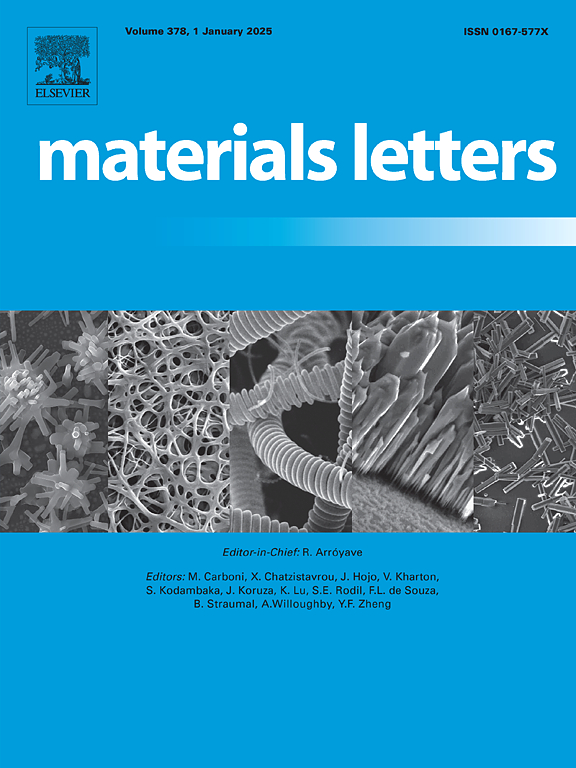轻松合成用于超级电容器的高性能独立分层多孔 NiO/Bi@Bi2O3 混合电极
IF 2.7
4区 材料科学
Q3 MATERIALS SCIENCE, MULTIDISCIPLINARY
引用次数: 0
摘要
通过巧妙利用 Bi 和 Ni 元素在电沉积过程中的不同化学特性,本研究成功设计出了一种具有双重电活性成分(NiO 和 Bi@Bi2O3)和分层多孔结构的新型独立式 NiO/Bi@Bi2O3 混合电极。共电泳后,多孔金属 Bi 作为导电骨架可有效提高电极的导电性。此外,Bi2O3 和 NiO 还能通过改变电子结构产生协同效应。新开发的双金属 NiO/Bi@Bi2O3 混合电极显示出 1166.67 F cm-3 的高体积电容值,这归功于结构和组成的双重优势。这项工作为设计高性能过渡金属氧化物基电极提供了新思路。本文章由计算机程序翻译,如有差异,请以英文原文为准。
Facile synthesis of high-performance free-standing hierarchically porous NiO/Bi@Bi2O3 hybrid electrode for supercapacitors
By tactfully utilizing the different chemical characteristics of Bi and Ni element in the electrodeposition process, this work successfully designs a novel free-standing NiO/Bi@Bi2O3 hybrid electrode with dual electroactive components (NiO and Bi@Bi2O3) and hierarchically porous structure. After co-electrodeposition, the porous Bi metal as a conductive skeleton can effectively improve the electrical conductivity of the electrode. Moreover, Bi2O3 and NiO have synergistic effects by modifying the electronic structure. The newly developed bimetallic NiO/Bi@Bi2O3 hybrid electrode exhibits high volumetric capacitance value of 1166.67 F cm−3, which is attributed to the dual advantages of structure and composition. This work provides a new idea for the design of high-performance transition metal oxide-based electrodes.
求助全文
通过发布文献求助,成功后即可免费获取论文全文。
去求助
来源期刊

Materials Letters
工程技术-材料科学:综合
CiteScore
5.60
自引率
3.30%
发文量
1948
审稿时长
50 days
期刊介绍:
Materials Letters has an open access mirror journal Materials Letters: X, sharing the same aims and scope, editorial team, submission system and rigorous peer review.
Materials Letters is dedicated to publishing novel, cutting edge reports of broad interest to the materials community. The journal provides a forum for materials scientists and engineers, physicists, and chemists to rapidly communicate on the most important topics in the field of materials.
Contributions include, but are not limited to, a variety of topics such as:
• Materials - Metals and alloys, amorphous solids, ceramics, composites, polymers, semiconductors
• Applications - Structural, opto-electronic, magnetic, medical, MEMS, sensors, smart
• Characterization - Analytical, microscopy, scanning probes, nanoscopic, optical, electrical, magnetic, acoustic, spectroscopic, diffraction
• Novel Materials - Micro and nanostructures (nanowires, nanotubes, nanoparticles), nanocomposites, thin films, superlattices, quantum dots.
• Processing - Crystal growth, thin film processing, sol-gel processing, mechanical processing, assembly, nanocrystalline processing.
• Properties - Mechanical, magnetic, optical, electrical, ferroelectric, thermal, interfacial, transport, thermodynamic
• Synthesis - Quenching, solid state, solidification, solution synthesis, vapor deposition, high pressure, explosive
 求助内容:
求助内容: 应助结果提醒方式:
应助结果提醒方式:


